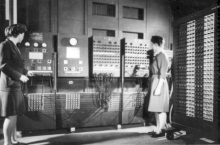ENIAC
ENIAC var ein av verdas første programmerbare elektroniske datamaskinar. Namnet stod for Electronic Numerical Integrator and Computer.[1][2] Han vart utvikla for hæren i USA, og kom i drift i 1945,[3][4] eit par år etter den britiske maskinen Colossus. Det opphavlege målet var å rekna ut ballistiske tabellar for skyting med artilleri,[5] men den fyrste oppgåva var å finna kor mogleg det var å laga termonukleære våpen.[6][7] Maskinen var i kontinuerleg drift fram til 1955.[2]
| ENIAC | |||
 | |||
| Type | one-of-a-kind computer, decimal computer | ||
|---|---|---|---|
| Designar | John Mauchly, J. Presper Eckert, Jeffrey Chuan Chu, Arthur Burks, Harry Huskey | ||
| Etterfølgjar | UNIVAC I | ||
Kjelder
endre- ↑ Eckert Jr., John Presper and Mauchly, John W.; Electronic Numerical Integrator and Computer, United States Patent Office, US Patent 3,120,606, filed 1947-06-26, issued 1964-02-04; invalidated 1973-10-19 after court ruling in Honeywell v. Sperry Rand.
- ↑ 2,0 2,1 Weik, Martin H. «The ENIAC Story». Ordnance (Washington, DC: American Ordnance Association) (January–Februar 1961). Arkivert frå originalen 14. august 2011. Henta 29. mars 2015.
- ↑ «3.2 First Generation Electronic Computers (1937-1953)». www.phy.ornl.gov.
- ↑ «ENIAC on Trial – 1. Public Use». www.ushistory.org. Search for 1945. Henta 16. mai 2018. «The ENIAC machine [...] was reduced to practice no later than the date of commencement of the use of the machine for the Los Alamos calculations, December 10, 1945.»
- ↑ Moye, William T. (January 1996). «ENIAC: The Army-Sponsored Revolution». US Army Research Laboratory. Arkivert frå originalen 21. mai 2017. Henta 29. mars 2015.
- ↑ Richard Rhodes (1995). «chapter 13». Dark Sun: The Making of the Hydrogen Bomb. s. 251. «The first problem assigned to the first working electronic digital computer in the world was the hydrogen bomb. […] The ENIAC ran a first rough version of the thermonuclear calculations for six weeks in December 1945 and January 1946.»
- ↑ McCartney 1999, s. 103: "ENIAC correctly showed that Teller's scheme would not work, but the results led Teller and Ulam to come up with another design together."